Experimental Evaluation of the Effects of Passive Phase Change Material Walls on the Building Demand Response for Smart Grid Applications
Abstract
:1. Introduction
- Global Temperature Adjustment (GTA): Buildings can achieve flexible energy consumption by adjusting the HVAC setpoint, such as by adjusting the set temperature of rooms during a DR event following enough precooling.
- System Regulation: This directly controls the HVAC system to reduce energy demand and change energy consumption, such as reducing the number of working fan coil units or turning off some of the main cooling units.
- Load Rebound Control: This includes progressively resuming energy consumption or extending a DR event.
2. Methodology
2.1. Experimental Platform
2.1.1. Outline of the Experimental Platform
2.1.2. Phase Change Material Walls
2.1.3. Data Acquisition
2.2. Experimental Program
2.2.1. Demand Response Experiment
2.2.2. Impact of Precooling Temperature on Precooling Performance
3. Results and Discussion
3.1. Impact of PCM Walls on the DR Performance of Buildings
3.1.1. Precooling Stage Analysis
3.1.2. Performance Analysis of the DR Event
- i.
- Reducing Energy Consumption Capability
- ii.
- Peak Load Reduction
3.1.3. Cooling Load Analysis
3.2. Impact of Precooling Temperature on Precooling Performance
3.2.1. Impact of Precooling Temperature on Precooling Time
3.2.2. Impact of Precooling Temperature on Precooling Energy Consumption
3.2.3. Precooling Performance Discussion
4. Conclusions
- After precooling the PCM walls and the Ordinary walls at 21 °C, an 11 h daily work stage was conducted with a 4 h GTA DR stage included. The PCM walls reduced the cooling load, electricity consumption, and peak electricity consumption of the experimental room by 75.05%, 49.57%, and 31.06%, respectively. Compared to the same conditions for the Ordinary walls, the PCM walls reduced the cooling load, electricity consumption, and peak consumption by 12.58%, 24.35%, and 12.73%, respectively. Therefore, using PCM walls can increase the thermal mass of the building envelope and provide higher DR potential in a GTA DR event. Overall, using a precooling stage can lead to higher energy consumption, but this can also be compensated for by lower electricity prices or the displacement of peak demand.
- Precooling temperature greatly affected the phase change precooling time. For every 1 °C decrease, the precooling time decreased by between 13.51 and 17.56%. As the precooling temperature decreased, the temperature difference increased, the precooling speed increased, and the precooling time decreased.
- As the precooling temperature decreased, the precooling time also decreased, but the unit time energy demand of the rooms increased. Their coupling effect affected the total precooling energy consumption. The cooling load first decreased and then increased, and the maximum reduction in room cooling load was 13.87%. While lower precooling temperatures accelerated the precooling process, this also increased energy consumption. For precooling with sufficient time and unchanged electricity prices, minimum energy consumption in achieving precooling should be considered. For precooling with limited time and large variation, a lower precooling temperature should be used to ensure the adequate performance of precooling and thus reduce energy consumption and the peak load during the DR event.
Author Contributions
Funding
Data Availability Statement
Acknowledgments
Conflicts of Interest
References
- Jiang, B.; Fei, Y. Dynamic Residential Demand Response and Distributed Generation Management in Smart Microgrid with Hierarchical Agents. Energy Procedia 2011, 12, 76–90. [Google Scholar] [CrossRef] [Green Version]
- Yuan, J.; Hu, Z. Low carbon electricity development in China—An IRSP perspective based on Super Smart Grid. Renew. Sustain. Energy Rev. 2011, 15, 2707–2713. [Google Scholar] [CrossRef]
- Gellings, C.W. Then and now: The perspective of the man who coined the term ‘DSM’. Energy Policy 1996, 24, 285–288. [Google Scholar] [CrossRef]
- Jordehi, A.R. Optimisation of demand response in electric power systems, a review. Renew. Sustain. Energy Rev. 2019, 103, 308–319. [Google Scholar] [CrossRef]
- O’connell, N.; Pinson, P.; Madsen, H.; O’malley, M. Benefits and challenges of electrical demand response: A critical review. Renew. Sustain. Energy Rev. 2014, 39, 686–699. [Google Scholar] [CrossRef]
- Wang, S.; Xue, X.; Yan, C. Building power demand response methods toward smart grid. HVAC&R Res. 2014, 20, 665–687. [Google Scholar]
- Koliou, E.; Eid, C.; Chaves-Ávila, J.P.; Hakvoort, R.A. Demand response in liberalized electricity markets: Analysis of aggregated load participation in the German balancing mechanism. Energy 2014, 71, 245–254. [Google Scholar] [CrossRef]
- Omer, A.M. Energy, environment and sustainable development. Renew. Sustain. Energy Rev. 2008, 12, 2265–2300. [Google Scholar] [CrossRef]
- Azar, A.G.; Olivero, E.; Hiller, J.; Lesch, K.; Jiao, L.; Kolhe, M.; Asanalieva, N.; Ferrez, P.; Zhang, Q.; Jacobsen, R.; et al. Algorithms for demand response and load control. SEMIAH, SEMIAH-WP5-D5 2015, 1-v0. [Google Scholar]
- He, X.; Hancher, L.; Azevedo, I.; Keyaerts, N.; Meeus, L.; Glachant, J.M. Shift, Not Drift: Towards Active Demand Response and Beyond; European University Institute: Fiesole, Italy, 2013. [Google Scholar]
- Kueck, J.D.; Ally, M.R.; Rice, C.K. Using Air Conditioning Load Response for Spinning Reserve; Oak Ridge National Laboratory: Oak Ridge, TN, USA, 2009.
- Olesen, B.W.; Brager, G.S. A Better Way to Predict Comfort: The New ASHRAE Standard 55-2004; University of California: Oakland, CA, USA, 2004. [Google Scholar]
- Wang, S.; Gao, D.C.; Tang, R.; Xiao, F. Cooling supply-based AC system control for fast demand response of buildings to urgent requests of smart grids. Energy Procedia 2016, 103, 34–39. [Google Scholar] [CrossRef]
- Cui, B.; Wang, S.; Yan, C.; Xue, X. Evaluation of a fast power demand response strategy using active and passive building cold storages for smart grid applications. Energy Convers. Manag. 2015, 102, 227–238. [Google Scholar] [CrossRef]
- Ran, F.; Gao, D.C.; Zhang, X.; Chen, S. A virtual sensor based self-adjusting control for AC fast demand response in commercial buildings towards smart grid applications. Appl. Energy 2020, 269, 115103. [Google Scholar] [CrossRef]
- Xue, X.; Wang, S.; Yan, C.; Cui, B. A fast chiller power demand response control strategy for buildings connected to smart grid. Appl. Energy 2015, 137, 77–87. [Google Scholar] [CrossRef]
- Ardito, L.; Procaccianti, G.; Menga, G.; Morisio, M. Smart Grid Technologies in Europe: An Overview. Energies 2013, 6, 251–281. [Google Scholar] [CrossRef] [Green Version]
- Rotger-Griful, S.; Jacobsen, R.H.; Nguyen, D.; Sørensen, G. Demand response potential of ventilation systems in residential buildings. Energy Build. 2016, 121, 1–10. [Google Scholar] [CrossRef]
- Motegi, N.; Piette, M.; Watson, D.; Kiliccote, S.; Xu, P. Introduction to Commercial Building Control Strategies and Techniques for Demand Response; LBNL-599754; Lawrence Berkeley National Laboratory: Berkeley, CA, USA, 2007.
- Yoon, J.H.; Bladick, R.; Novoselac, A. Demand response for residential buildings based on dynamic price of electricity. Energy Build. 2014, 80, 531–541. [Google Scholar] [CrossRef]
- Aduda, K.; Labeodan, T.; Zeiler, W.; Boxem, G.; Zhao, Y. Demand side flexibility: Potentials and building performance implications. Sustain. Cities Soc. 2016, 22, 146–163. [Google Scholar] [CrossRef]
- Kang, J.; Weng, S.; Li, Y.; Ma, T. Study of Building Demand Response Method Based on Indoor Temperature Setpoint Control of VRV Air Conditioning. Buildings 2022, 12, 415. [Google Scholar] [CrossRef]
- Hu, M.; Xiao, F.; Jørgensen, J.B.; Li, R. Price-responsive model predictive control of floor heating systems for demand response using building thermal mass. Appl. Therm. Eng. 2019, 153, 316–329. [Google Scholar] [CrossRef]
- Chen, Y.; Xu, P.; Chen, Z.; Wang, H.; Sha, H.; Ji, Y.; Zhang, Y.; Dou, Q.; Wang, S. Experimental investigation of demand response potential of buildings: Combined passive thermal mass and active storage. Appl. Energy 2020, 280, 115956. [Google Scholar] [CrossRef]
- Saffari, M.; Conor, R.; Donal, P.F. Improving the building energy flexibility using PCM-enhanced envelopes. Appl. Therm. Eng. 2022, 217, 119092. [Google Scholar] [CrossRef]
- Kishore, R.A.; Bianchi, M.V.; Booten, C.; Vidal, J.; Jackson, R. Modulating thermal load through lightweight residential building walls using thermal energy storage and controlled precooling strategy. Appl. Therm. Eng. 2020, 180, 115870. [Google Scholar] [CrossRef]
- Becker, R. Improving thermal and energy performance of buildings in summer with internal phase change materials. J. Build. Phys. 2013, 37, 296–324. [Google Scholar] [CrossRef]
- Xu, P.; Haves, P.; Piette, M.A.; Braun, J. Peak Demand Reduction from Pre-Cooling with Zone Temperature Reset in an Office Building; No. LBNL-55800; Lawrence Berkeley National Lab. (LBNL): Berkeley, CA, USA, 2004.
- Kant, K.; Shukla, A.; Sharma, A. Advancement in phase change materials for thermal energy storage applications. Sol. Energy Mater. Sol. Cells 2017, 172, 82–92. [Google Scholar] [CrossRef]
- Darby, S.J. Smart electric storage heating and potential for residential demand response. Energy Effic. 2017, 11, 67–77. [Google Scholar] [CrossRef]
- Rahimpour, Z.; Verbic, G.; Chapman, A.C. Energy management of buildings with phase change materials based on dynamic programming. In Proceedings of the 2019 IEEE Milan PowerTech, Milano, Italy, 23–27 June 2019. [Google Scholar]
- Wang, X.; Li, W.; Luo, Z.; Wang, K.; Shah, S.P. A critical review on phase change materials (PCM) for sustainable and energy efficient building: Design, characteristic, performance and application. Energy Build. 2022, 260, 111923. [Google Scholar] [CrossRef]


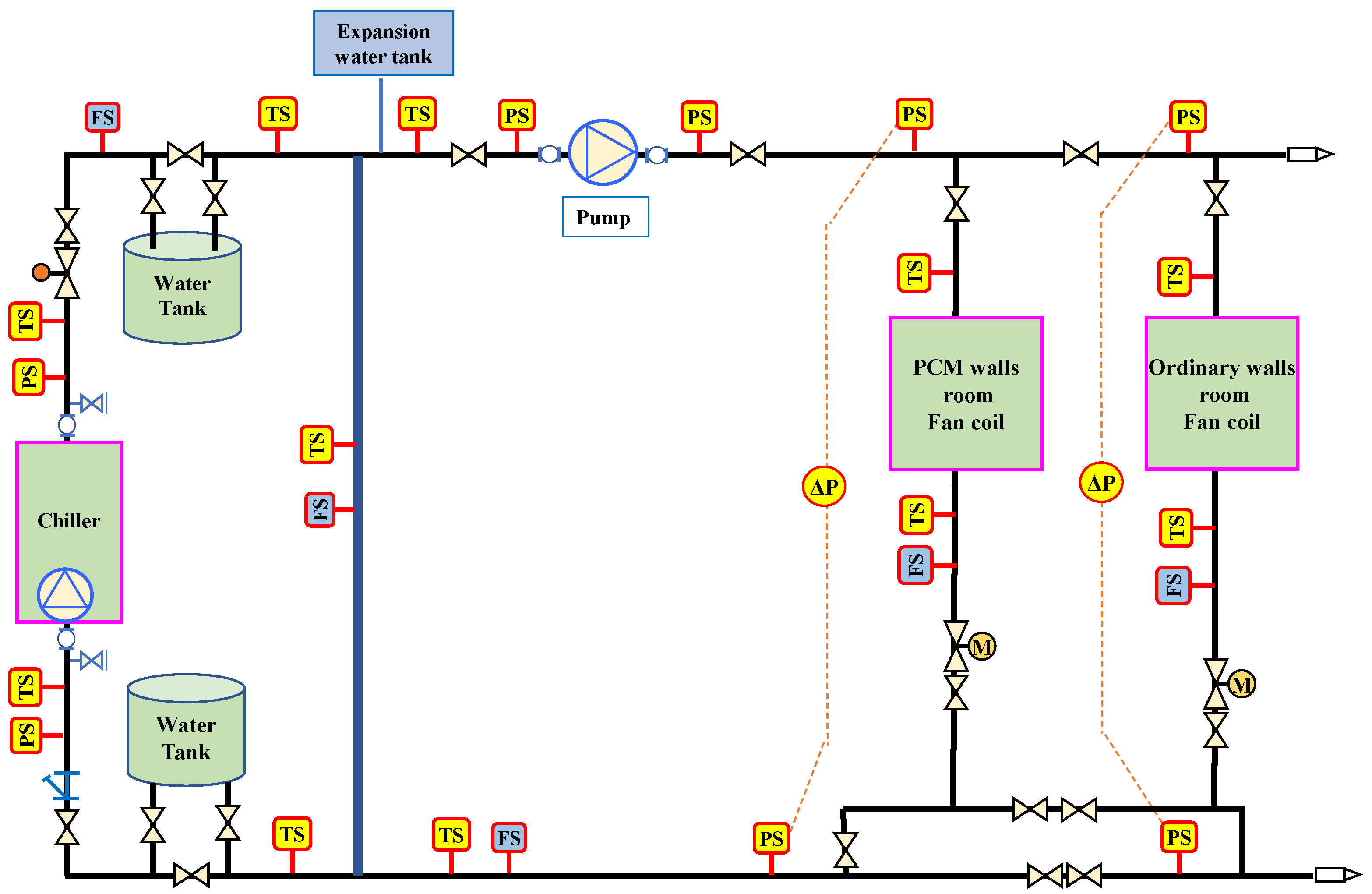

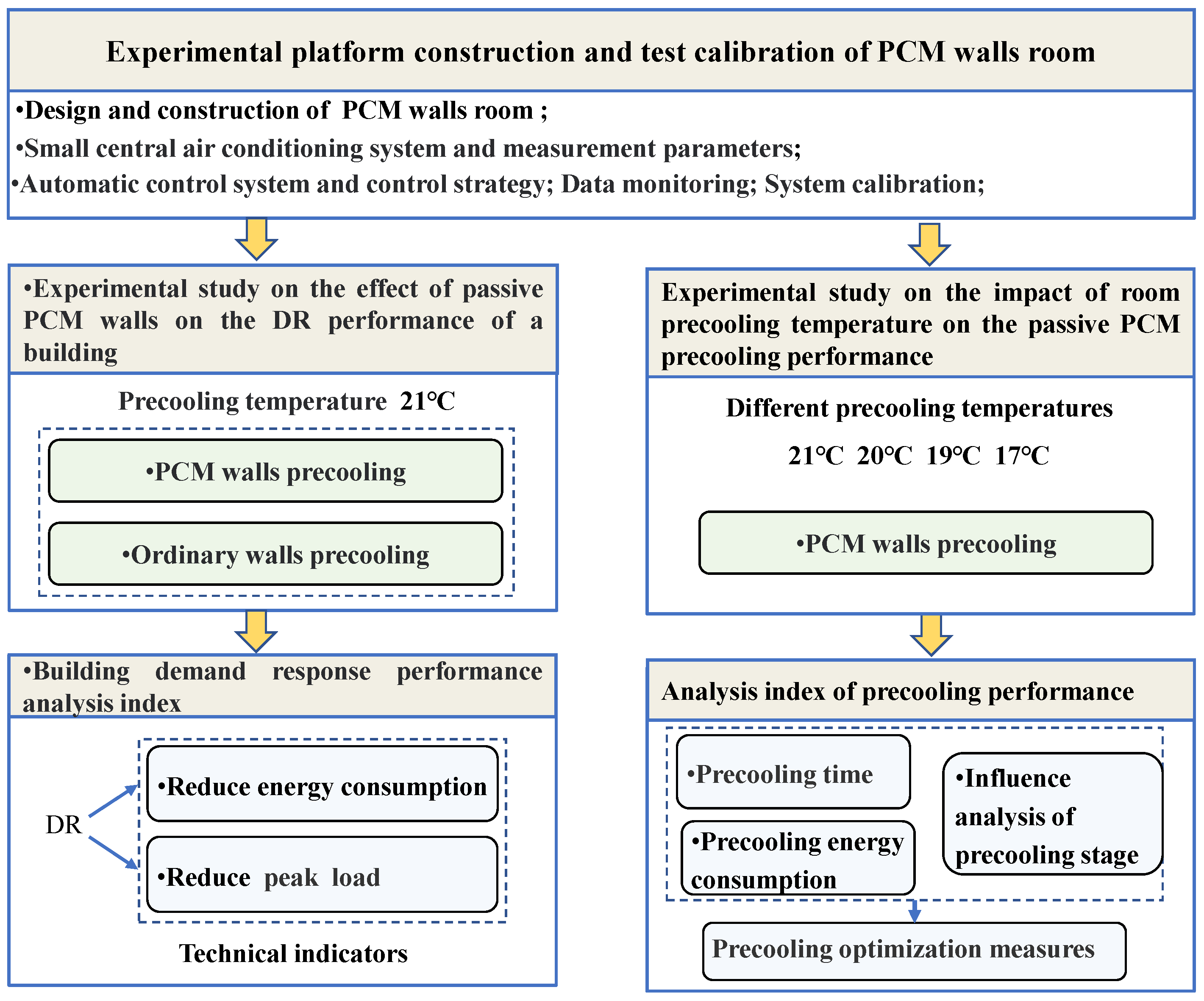

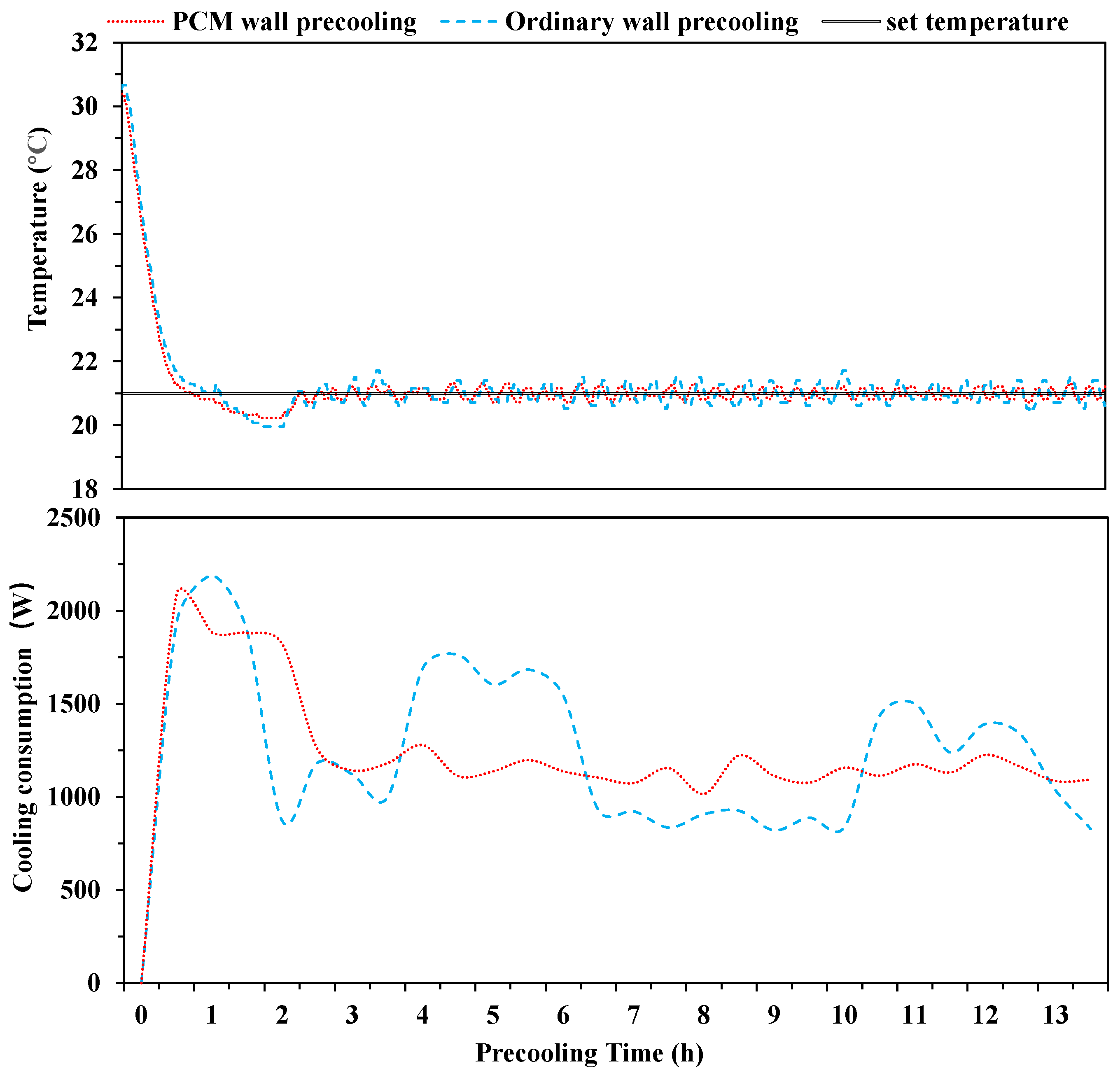

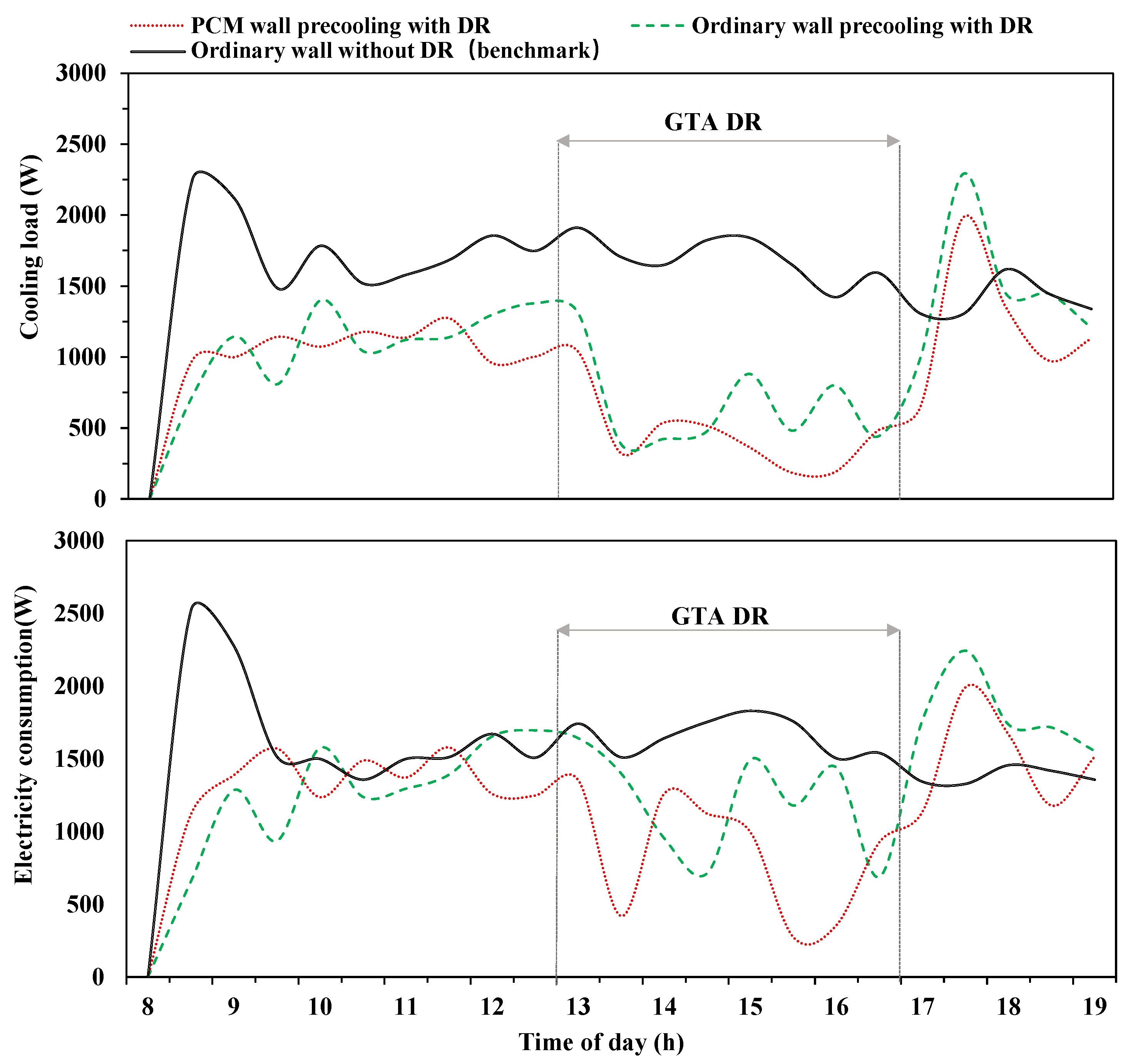
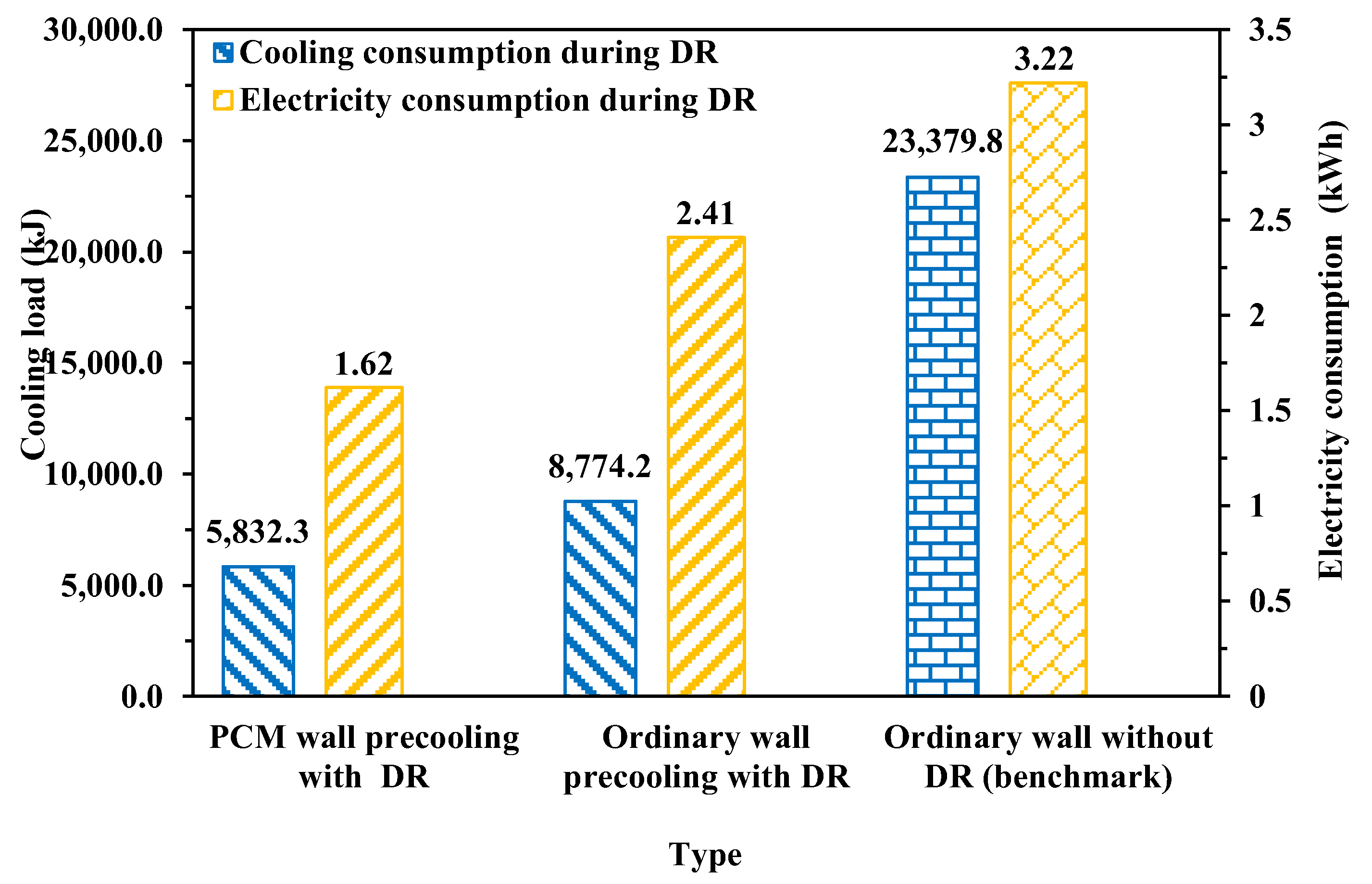
| Meter Type | Model | Accuracy |
|---|---|---|
| Liquid pressure transmitter | P499VBS-404C-C | 1% |
| Water pipe temperature sensor | TE-631AM-1 | ±0.19 °C |
| Air temperature and humidity sensor | SOC-H1T1 | ±2% RH, ±0.3 °C |
| Flow Sensor | JBS-LWGY-C25L | 0.5% |
| AC voltage transmitter | MIK-SDJU-A | 0.5% |
| AC Current transmitter | MIK-SDJI | 0.5% |
| Omega thermocouple | T type | 0.4% |
| Type | Peak Load (W) | Peak Load Reduction (W) | Reduction Ratio (%) |
|---|---|---|---|
| Type A | 1135.71 | 511.69 | 31.06 |
| Type B | 1345.42 | 301.99 | 18.33 |
| Type C | 1647.41 | 0.00 | 0.00 |
| Type | Precooling Stage Cooling Load (kJ) | Daily Work Stage Cooling Load (kJ) | Total Cooling Load (kJ) |
|---|---|---|---|
| Type A | 62,328.77 | 35,027.9 | 97,356.6 |
| Type B | 62,613.24 | 40,747.6 | 103,361 |
| Type C | 0 | 65,897.1 | 65,897.1 |
| Type | Precooling Time (h) | Time Decrease (h) | Time Decrease (%) | Unit Time Decrease (%) |
|---|---|---|---|---|
| 21 °C PCM walls precooling | 13.85 | 0.00 | 0.00 | 0.00 |
| 20 °C PCM walls precooling | 11.83 | 2.02 | 14.58 | 17.56 |
| 19 °C PCM walls precooling | 10.20 | 3.65 | 26.35 | 13.51 |
| 17 °C PCM walls precooling | 8.25 | 5.60 | 40.43 | 13.94 |
| Type | Precooling Cooling Load (kJ) | Cooling Decrease (kJ) | Cooling Decrease (%) | Unit Cooling Decrease (%) |
|---|---|---|---|---|
| 21 °C PCM walls precooling | 68,829.70 | 0.00 | 0.00 | 0.00 |
| 20 °C PCM walls precooling | 63,509.00 | 5320.70 | 7.73 | 9.31 |
| 19 °C PCM walls precooling | 59,285.50 | 9544.20 | 13.87 | 7.11 |
| 17 °C PCM walls precooling | 65,718.00 | 3111.70 | 4.52 | 1.56 |
Publisher’s Note: MDPI stays neutral with regard to jurisdictional claims in published maps and institutional affiliations. |
© 2022 by the authors. Licensee MDPI, Basel, Switzerland. This article is an open access article distributed under the terms and conditions of the Creative Commons Attribution (CC BY) license (https://creativecommons.org/licenses/by/4.0/).
Share and Cite
You, Z.; Sun, Y.; Mo, S.; Zou, W.; Zhang, X.; Gao, D.-c. Experimental Evaluation of the Effects of Passive Phase Change Material Walls on the Building Demand Response for Smart Grid Applications. Buildings 2022, 12, 1830. https://doi.org/10.3390/buildings12111830
You Z, Sun Y, Mo S, Zou W, Zhang X, Gao D-c. Experimental Evaluation of the Effects of Passive Phase Change Material Walls on the Building Demand Response for Smart Grid Applications. Buildings. 2022; 12(11):1830. https://doi.org/10.3390/buildings12111830
Chicago/Turabian StyleYou, Zhiqiang, Yongjun Sun, Shanjun Mo, Wenke Zou, Xu Zhang, and Dian-ce Gao. 2022. "Experimental Evaluation of the Effects of Passive Phase Change Material Walls on the Building Demand Response for Smart Grid Applications" Buildings 12, no. 11: 1830. https://doi.org/10.3390/buildings12111830






